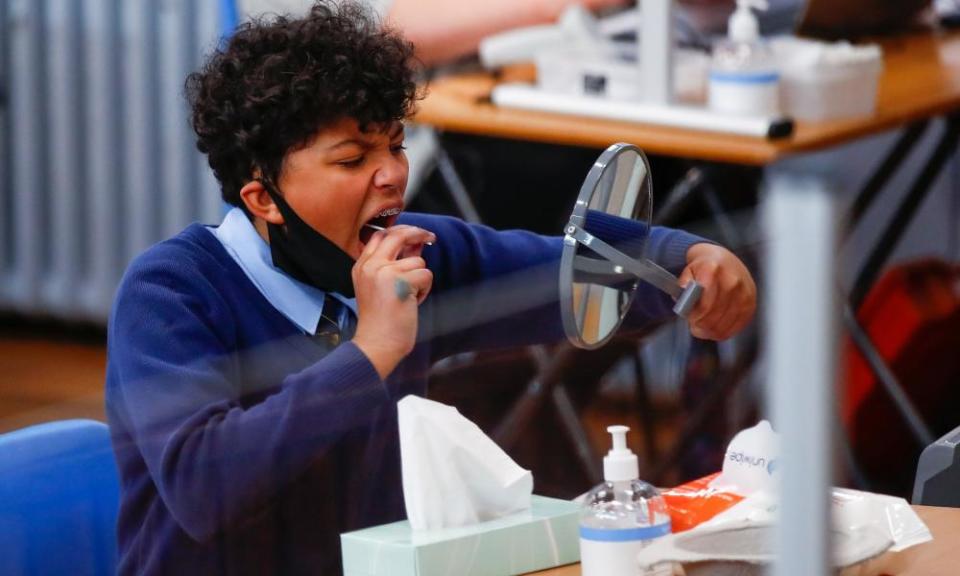Deep within the UK’s shocking Covid data, there may be reasons for optimism

It is hard to be upbeat about the latest numbers. The government’s Covid dashboard is awash with red and upward-pointing arrows. New cases have climbed 17% on the week. Hospital admissions are up 11% and deaths have increased by 21%. This is not where we wanted to be nearly two years into the pandemic – and 10 months into the most successful mass vaccination campaign in the history of the NHS.
So is this what we have to get used to? Nearly 1,000 hospital admissions a day, and nearly 1,000 deaths a week? There are so many forces at work in a pandemic, operating on different timescales, pushing in opposite directions, that reliable predictions are a fantasy. But delve into the data and there are, perhaps, some reasons for optimism.
With so many adults well protected after vaccination, infection, or both, the primary driver for the UK epidemic is the infection rate among schoolchildren. Data from the Office for National Statistics show that cases soared in secondary schools when they reopened after the summer. This was bound to happen: in England at least, protective measures in schools were minimal; the decision to vaccinate healthy children came later than elsewhere, and the process has been difficult and slow.
The ONS estimates that for the week ending 9 October, 8.1% of children in school years 7 to 11 would have tested positive for coronavirus. This equates to about 5% becoming infected every week and adding to the pool of the immune. Before schools went back after the summer, a substantial minority of children in London may have had antibodies to the virus. With natural infections building on that immunity for weeks, cases may soon start to fall. And since schoolchildren are seeding infections into the community, national cases may follow suit.
Watch: COVID-19 - Health minister denies existence of Plan C to ban Christmas household mixing
But England is not London, and not all children are equally protected. In London, fresh cases of Covid are barely increasing, suggesting the capital may be close to a peak – at least for now. In the south-west, where immunity in children is thought to have been much lower before schools went back, cases are rising fast. If herd immunity starts to drive cases down, it will happen city by city, region by region, not in a coordinated wave across the UK. As ever, other factors muddy the waters, not least mixing patterns among adults. In London, for example, home-working rates are far higher than in many other places, keeping exposure levels down.
One question modellers are keen to answer is how much can Scotland tell us. When secondary schools in Scotland opened in mid- to late August, the percentage of students testing positive rose sharply. Depending on the age group, the rates peaked at 8%-10% before cases started to fall. At the same time, in early September, national cases fell sharply. Daily cases in Scotland more than halved in a month.
England may follow suit in the weeks ahead, but there is uncertainty. Scotland was faster to vaccinate schoolchildren, so their immunity before returning to school may have been higher than for children in England. If the tide has started to turn in teenagers in England, the first sign may be a slowing of infections in the ONS data this Friday.
Not that that will be the end of it. Vaccines are good at preventing severe disease but do far less to stop the virus from spreading, and immunity is steadily waning, especially in vulnerable people. Meanwhile, children are the only ones close to pre-epidemic levels of contact with others. Adults have not returned to anything like previous levels of mixing, though it is starting to increase. To top it all, as Chris Whitty, England’s chief medical officer, would say, “winter is coming”. All could drive further waves in infections.
John Edmunds, a member of Sage and professor in the faculty of epidemiology and population health at the London School of Hygiene & Tropical Medicine, said while the epidemic has looked relatively stable over the past few months, “this has masked large changes under the surface, with rises and falls in levels of immunity in different age groups being generated by different processes – levels of immunity are rapidly increasing in children due to sky-high infection rates, whereas immunity is falling in older age groups who were vaccinated earlier in the year”.
He added: “How these dynamics play out is very difficult to predict right now, but it is clear that speeding up the vaccine rollout in children and boosters in adults will help both in the short and longer term.”
Watch: What UK government COVID-19 support is available?

 Yahoo Finance
Yahoo Finance 